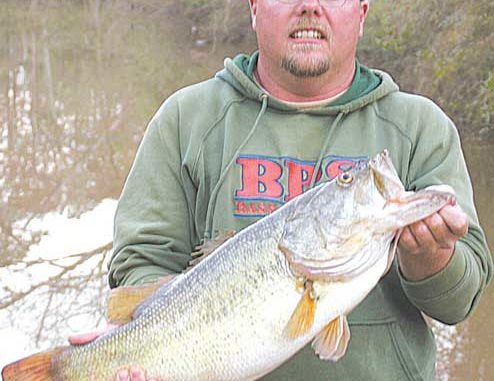Diversionary Tactics

Put these methods to work at the resurgent Lake Cataouatche, and you’ll be shocked at how active bass can be in May.
I climbed into Capt. Frank Lawson’s Champion bay boat fully expecting to catch redfish. The fact that he was tying on three bass lures only made me think that he would be showing me how to use bass tactics to catch redfish.
As we sped through Lake Salvador, I begin to wonder what was going on. We were riding right over huge schools of big reds without even stopping. It was then that I had my first inkling that Lawson had been tying on those bass baits because he wanted to catch some bass.
It turned out that Lawson knew exactly what he was doing. Before the bottom of the sun could break free from the horizon, we had already battled several chunky bass. The bites seemingly came from every direction, and as long as we worked our buzz baits parallel to the edges of the grass that surrounded us, we were rewarded with the slurping sounds of bass swallowing our lures.
There seemed to be an inverse relationship between the height of the sun and the number of strikes we got. As soon as it looked like our topwater bite had ended, Lawson turned to me and asked if I wanted to stick with the bass or go chase some redfish.
The redfish won out, but that didn’t stop my fascination with Lake Cataouatche. And if what I hear about the lake today is true, there are a lot more people fascinated with the water body than me. In fact, word is that not even weekdays can diminish the amount of fishing pressure that Cataouatche has been getting this year. Fishing may have been good last year, but this year it’s been great.
“If you go, be prepared to fish in a crowd,” said Lighthouse Bassmasters president Rodney Teel. “Cataouatche is definitely under a lot of pressure. There are 100 boats out there just about every day. A light day during the middle of the week would still have 50 or 60 boats all out there trying to do the same thing — catch big bass.”
Teel knows a thing or two about catching big bass out of Cataouatche. He landed a 10.81-pound lunker in February during a week in which there were three other bass over 10 pounds caught from Cataouatche — not to mention numerous 8- and 9-pounders.
If all these big bass are news to you, don’t feel bad. Lake Cataouatche isn’t exactly synonymous with big bass outside Southeast Louisiana. In fact, many anglers in Southeast Louisiana may not even be aware of just how good bass fishing is in this lake.
However, if the combination of stocked Florida bass and muddy Mississippi River water continue to do their thing, everybody will be hearing about Cataouatche in the future.
“The diversion that comes from Davis Pond flows right into Cataouatche,” said Lawson. “It floods the area with Mississippi River water, and I think that’s why the fishing is so good there right now. The water from the diversion pushes a lot of silt and sand into Cataouatche, and that’s one of the reasons the grass is growing so much. The lake has a good foundation now; it’s not just a bunch of mud on the bottom.”
Teel agreed with Lawson’s assessment, and added that there are a lot of similarities to Cataouatche now and Delacroix back in its heyday. The same things that made Delacroix such a great fishery are now taking place at Cataouatche.
“The only difference between the two is that here at Cataouatche, the water flows directly into the lake, whereas over at Delacroix, it flows from Caernarvon through a series of canals before it gets out into Lake Lery,” he said. “The water doesn’t have as long to warm up, so it keeps Cataouatche from getting stagnant. In the summer, that’s important because it keeps the water cooler.”
Although it’s possible for an angler to pick a grass patch and start fishing, Lawson and Teel believe you can up your odds of catching lots of fish by fishing areas that are known to hold lots of bass. And their general consensus is that the western side of the lake offers better bass fishing than the eastern side.
It’s not that there aren’t any bass living in the eastern side, but those that do are generally smaller than the fish to the west. And for whatever reason, there seems to be more redfish to the east. In fact, the eastern section of Cataouatche can get loaded with redfish during the summer.
Another reason bass fishing tends to be better to the west is that when the Davis Pond diversion is pumping at full throttle, most of that water comes out of the canals and moves over to the east toward Bayou Segnette. This leaves areas like Bayou Couba, the Tank Pond and the Umbrella Canal to the west pretty clean.
Catching bass during May means either getting there early enough to take advantage of the topwater bite first thing in the morning or fishing a cloudy day, which will extend the surface bite through the middle of the afternoon.
“You can catch bass other ways, but May is definitely a topwater month,” Lawson said. “During low-light conditions, those bass will move up high in the water and roam around looking for something to eat. I keep a buzz bait tied on for fishing the edges of the grass, and I keep a frog tied on for fishing on top of the mats. One of those two baits is going to catch fish for you if the topwater bite is on.”
Teel is a big believer in topwaters, too, and he generally begins his May mornings fishing about 40 or 50 yards out in front of the canal in the northwest corner of the lake called the Umbrella Canal. This area is made up of a little channel that comes out of the canal, and it is surrounded by grass.
“You can get in front of that canal and roll a buzz bait, Horny Toad or Ribbit — even a Rat-L-Trap — and they’ll eat it up,” he said. “Especially in May. It can grass up pretty bad in this area, but our springs have been cool enough the past few years that it’s keeping the grass from getting as thick as it could.”
After the topwater bite dies, Lawson and Teel both say the fishing can get a bit more interesting because the high afternoon sun will push bass under the thick mats of grass where they would rather wait on an eating opportunity to come to them than going out and finding something on their own.
Lawson’s go-to bait for fishing the grass during the afternoon is a Zoom Super Fluke. With this bait, he can fish it high and try to draw suspended fish out of the grass, or he can let it sink down in the holes to target bass that don’t want to move. He believes the Flukes are especially cut out for fishing grass that is in clear water.
“A lot of times, those bass will sit at the edge of one of those holes in the grass just waiting on something to come by,” said Lawson. “I can jerk a Fluke up to the edge of a hole and just kill it. That bait falling down into a hole in the grass is too much for them to stand. They’ve got to eat it.”
Teel takes the traditional approach after bass retreat into the grass. He likes to fish either a plastic worm or a Swimming Senko rigged with as light a weight as he can get away with based on the wind. If conditions allow, Teel fishes both plastics with a 1/16-ounce weight, but he will go to a 1/8-ounce lead if he needs to.
“Watermelon and red shad both work well,” he said. “I just kind of pull either lure over the grass and drop it into the holes. I also like to fish them around the sparse grass that has lots of edges. You just kind of pull it through the grass, and if you feel it pick up any grass, shake it and it will pull loose. That action may even get a bass to bite.”
Although Teel loves the worm and Swimming Senko, he did mention that bass in Cataouatche would eat Texas-rigged creature baits, too. For example, the 10.81-pound bass he caught in February came on a Sweet Beaver. The Zoom Baby Brush Hog is another popular option for fishing through the grass.
With this kind of phenomenal bass-fishing so close to New Orleans, Teel feels like it’s important for anglers to throw some fish back.
“Taking all those 3-, 4- and 5-pound bass out of there will kill that lake,” Teel said. “I think once they reach that 3-pound range, they really need to be put back. With so many people out there, if they all keep two 3-pounders, it won’t take long to ruin the fishing.”
Teel encouraged anglers who want to keep fish to consider icing the smaller 12-inch bass that are so abundant throughout Cataouatche. In fact, since there’s no minimum length limit, keep those 10- to 12-inch bass. They’ll taste a lot better anyway.
Now that I know just what kind of bass fishing Cataouatche offers, maybe next time I won’t be so quick to chase the reds when Lawson wants to take me bass fishing. I can catch a 10-pound redfish anytime. A 10-pound bass, well, that’s another story.



